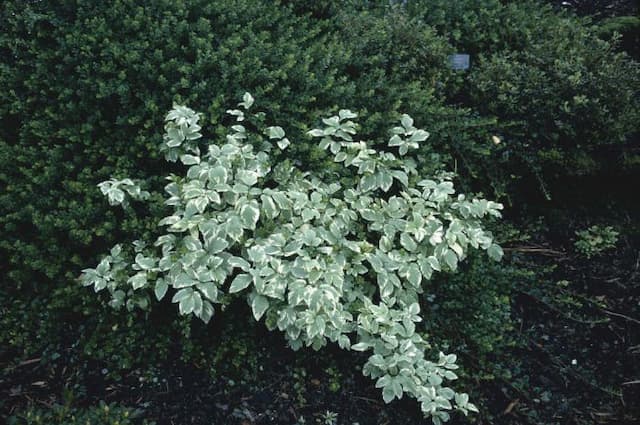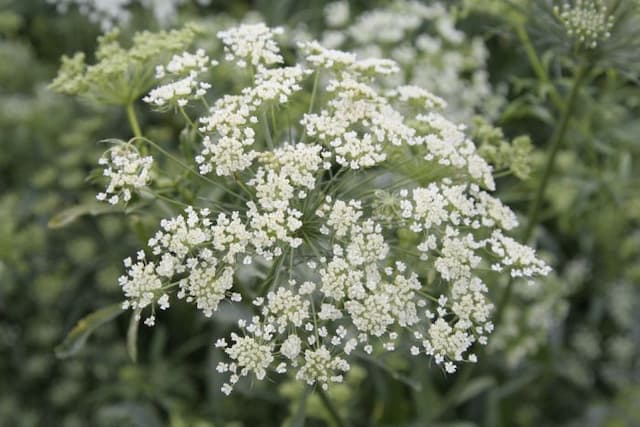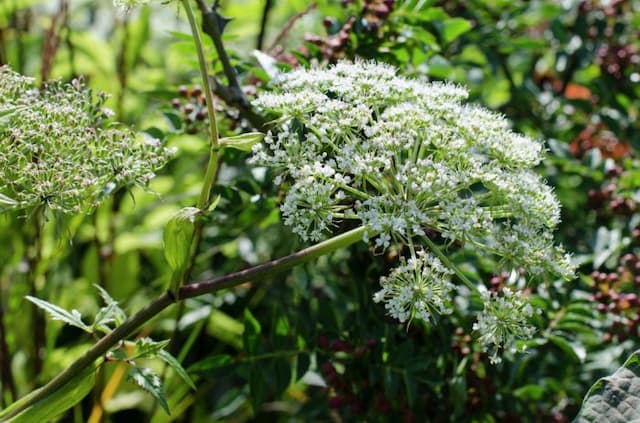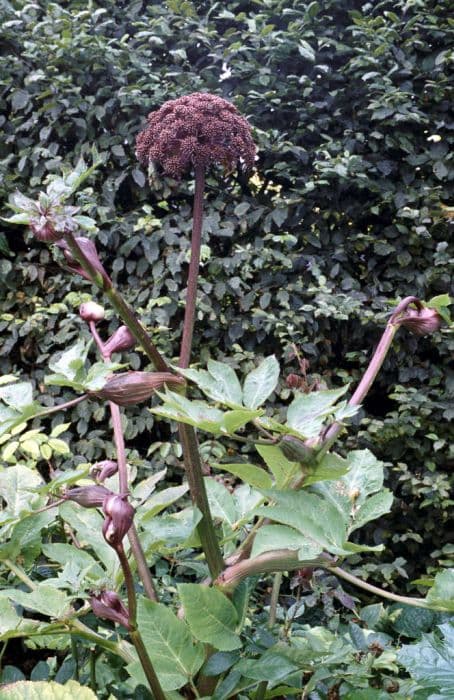Sanicle Sanicula epipactis

ABOUT
Sanicula epipactis, commonly known as the Sanicle, is a flowering plant characterized by a lush green appearance. It bears leaves that are broad and lobed, reminiscent of common maple leaves, with a glossy texture that catches the light. The leaves often form as a rosette at the base, emanating a vibrant green hue. The flowers are quite distinctive, typically small and grouped in umbrella-like clusters, known as umbels. These clusters emerge atop slender, erect stems protruding from among the foliage. The flowers themselves are inconspicuous, generally greenish-white, and can be nestled among spiny bracteoles that add a touch of intricacy to the bloom structure. Upon closer inspection, the plant's little spherical fruits may be seen nestled among the flowers. Each fruit is covered in hooked spines that enable them to latch onto passing animals for seed dispersal. The entire plant exudes a somewhat wild and untamed charm due to these bristly fruits and the lush, serrated leaves. Overall, the Sanicle presents itself with a humble yet captivating appearance that can attract those interested in native plants and woodland botany.
About this plant
 Names
NamesFamily
Apiaceae.
Synonyms
No common names available.
Common names
Sanicula europaea var. epipactis.
 Toxicity
ToxicityTo humans
Sanicula epipactis, commonly known as Sanicle, does not have a well-documented profile of toxicity to humans. There is limited information available regarding the ingestion of this plant by humans, and as such, its potential toxic effects and symptoms are not well known. It is advisable to avoid ingesting any part of the plant due to the uncertainty of its effects.
To pets
The toxicity of Sanicula epipactis, or Sanicle, to pets such as cats and dogs is not established in the available literature. Symptoms of poisoning and the potential consequences of pets ingesting any part of this plant are not well documented. Due to the lack of specific information on its toxicity, it is prudent to keep pets from ingesting Sanicle as a precautionary measure.
 Characteristics
CharacteristicsLife cycle
Perennials
Foliage type
Deciduous
Color of leaves
Green
Flower color
Greenish
Height
1-2 feet (30-60 cm)
Spread
1-2 feet (30-60 cm)
Plant type
Herb
Hardiness zones
5
Native area
Europe
Benefits
 General Benefits
General Benefits- Ecosystem Support: Sanicula epipactis, commonly known as snakeroot, often serves as an important food source for various wildlife, including insects and birds.
- Soil Stabilization: The root systems of snakeroot can help to reduce soil erosion in areas where it's planted or grows naturally.
- Biodiversity Preservation: As a native species in its respective habitats, snakeroot contributes to maintaining local biodiversity.
- Ornamental Use: With its unique flowers and foliage, snakeroot can be used to add diversity to garden landscapes.
- Ecological Indicator: The presence of snakeroot can be an indicator of the health of an ecosystem, as it may signify undisturbed soil and a diverse plant community.
- Food Source for Pollinators: Snakeroot flowers provide nectar and pollen for bees and other pollinating insects, which are crucial for the pollination of many plants.
 Medical Properties
Medical PropertiesThis plant is not used for medical purposes.
 Air-purifying Qualities
Air-purifying QualitiesThis plant is not specifically known for air purifying qualities.
 Other Uses
Other Uses- Sanicula epipactis, commonly known as Snakeroot, can be used as a ground cover in shaded woodland gardens due to its spreading nature and shade tolerance.
- The plant can be incorporated into a rain garden design as it may tolerate wet conditions occasionally found in this type of garden environment.
- Snakeroot may be used in butterfly gardens, as some species of Lepidoptera use the plant as a host for their larvae.
- The plant’s distinct foliage texture can add visual interest in a mixed border or shade garden when contrasted with plants having larger or differently shaped leaves.
- Snakeroot can be integrated into naturalized areas or wildflower meadows to foster a more diverse ecosystem that supports various wildlife.
- Students of botany and horticulture may use the plant for educational purposes to study the characteristics of the Apiaceae family to which it belongs.
- Its resilience makes it suitable for erosion control on shaded slopes where other plants might struggle to grow.
- Snakeroot can be used in cut flower arrangements, particularly in rustic or woodland-themed designs, providing a wild and natural look.
- The seeds of Snakeroot can provide food for birds and small mammals, thereby supporting local biodiversity.
- Photographers and artists may find inspiration in the delicate structure of Snakeroot’s flowers and leaves for their creative projects.
Interesting Facts
 Feng Shui
Feng ShuiSanicula epipactis, commonly known as sanicle, is not used in Feng Shui practice.
 Zodiac Sign Compitability
Zodiac Sign CompitabilitySanicula epipactis, commonly known as sanicle, is not used in astrology practice.
 Plant Symbolism
Plant Symbolism- Healing – Sanicula epipactis, commonly known as Sanicle, has been traditionally used in various cultures for its medicinal properties, often symbolizing healing and the treatment of ailments.
- Protection – The plant's historical use in folk medicine and old beliefs in its protective qualities has led Sanicle to be associated with protection against evil and harm.
- Purity – With its preference for growing in clean, unpolluted woods, Sanicle is sometimes viewed as a symbol of purity and cleanliness.
 Water
WaterThe Mission Bells, commonly known as Sanicula epipactis, should be watered deeply but infrequently, allowing the top inch of soil to dry out between waterings. Generally, watering once a week with about one to two gallons, depending on the size of the plant and environmental conditions, is sufficient. Overwatering or allowing the plant to sit in water can lead to root rot, so ensure good drainage. During the cooler months, you can reduce watering frequency.
 Light
LightMission Bells thrive best in partial shade to dappled sunlight. They prefer a location that mimics their natural woodland habitat, receiving morning sun and afternoon shade, or a spot under a canopy of trees that allows filtered light through. Avoid placing them in direct, harsh sunlight as it can scorch the leaves.
 Temperature
TemperatureMission Bells prefer moderate temperature ranges, typically between 60 to 75 degrees Fahrenheit. They can tolerate a minimum temperature down to around 50 degrees Fahrenheit and a maximum up to about 80 degrees Fahrenheit. These plants enjoy conditions that simulate a cool, forest-like environment and may suffer if subjected to extreme heat or frost.
 Pruning
PruningMission Bells should be pruned to remove dead or yellowing leaves and spent flower stems to encourage a tidy growth habit and more blooms. Pruning is best done after the flowering season, typically in late summer or early fall. This light pruning once a year is generally enough to maintain plant health and appearance.
 Cleaning
CleaningAs needed
 Soil
SoilSanicle prefers a well-draining soil mix rich in organic matter with a slightly acidic to neutral pH of about 6.0 to 7.0. A mix of loamy soil, peat moss, and perlite or sand can create the ideal growing environment for this woodland perennial.
 Repotting
RepottingSanicle typically does not require frequent repotting and can be repotted every 2-3 years or when it has outgrown its current pot, to prevent root bounding and to refresh the soil.
 Humidity & Misting
Humidity & MistingSanicle thrives in moderate to high humidity levels, similar to its natural forest habitat. Aim for humidity levels around 50-60% for optimal growth.
 Suitable locations
Suitable locationsIndoor
Place Sanicle in filtered light, ensure high humidity, and use well-draining soil.
Outdoor
In shade or partial sun, plant Sanicle in moist, rich soil.
Hardiness zone
The Sanicle plant is suitable for USDA hardiness zones 5-9.
 Life cycle
Life cycleSanicula epipactis, commonly known as Mission sanicle, begins its life cycle as a seed that germinates in moist, shaded soil conditions typically found in its woodland habitats. After germination, it develops a rosette of basal leaves, which are key for photosynthesis and early growth. The plant then matures and sends up a flowering stem, culminating in the production of small, inconspicuous flowers which are typically greenish-white and clustered in umbels. Following pollination, which is often assisted by insects, the flowers develop into burr-like fruits that are covered in hooks, enabling them to disperse by attaching to fur, feathers, or clothing. The seeds within these fruits lie dormant until the next suitable growing season when they germinate to start the cycle again. As a perennial, Mission sanicle may also grow and spread clonally through its rhizome, thus widening its reach within its growing area.
 Propogation
PropogationPropogation time
Spring to early summer
Sanicula epipactis, commonly known as sanicle, is typically propagated through seed. The most popular method of propagation for sanicle involves collecting the seeds when they mature, which usually occurs in late summer or early fall. After collection, the seeds should be sown immediately as they lose viability quickly when stored. Sowing can be done in a cold frame or outdoors in a nursery bed. It's important to keep the soil moist until germination, which might take several weeks. Once seedlings have developed sufficiently and can be handled, they are usually pricked out into individual pots and grown on in cooler conditions until they are strong enough to be planted out in their permanent positions, generally in the following spring.









